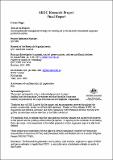| Abstract | Two species of rodents (Rattus sordidus and Melomys burtoni) are currently the most significant vertebrate pests in the Queensland sugar industry. Comprehensive management plans exist for Rattus sordidus, but Melomys burtoni has a different biology, ecology and damage profile. An understanding of the biology and ecology of Melomys burtoni is central to the development of an integrated pest management strategy for this species. Eight study sites were selected within the sugarcane production area between Tully and Silkwood in far north Queensland. Rodent trapping in cane was undertaken to determine the time and extent of colonisation and reproductive success of colonists after establishment. Data collection continued for 15 months; from February 2005 to April 2006. This intensive trapping phase allowed identification of environment/habitat correlates associated with colonisation, reproductive success and subsequent damage. Diet studies and damage assessments were undertaken to provide information on important organism/environment interactions (ie. the weak link in the dynamic cycle eg. reducing weed cover). The field studies revealed that M. cervinipes are rarely caught in sugarcane and should not be regarded as a pest by the industry. However, numbers of Melomys burtoni within the crop are equal to numbers of Rattus sordidus once the crop canopy develops to near closure (≈83%). Both M. burtoni and R. sordidus are in higher numbers when sugarcane crops are grown adjacent to grasslands rather than closed forest areas. All age classes of both sexes of M. burtoni utilise sugarcane and weed/grass seed in their diet but, the protein from seed does not promote the same level of breeding that can be observed in R. sordidus. The highest proportion of Melomys burtoni reproduction occurred during the later stages of crop development and this corresponded directly with the highest proportion of juvenile recruitment. This has important implications in that due to a later colonisation period and lower breeding potential, strategies for management of Melomys burtoni are not likely to be the same as those that have led to effective management of Rattus sordidus. Moreover, damage assessments revealed that Melomys burtoni were responsible for damage to ~6% of stalks. |

